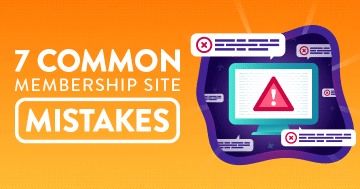So, you want to start a membership site?
Great! No surprises here that we think running a membership site is the best way to share your expertise, create a business with recurring revenue, and enjoy the many lifestyle benefits that a membership site business model has to offer.
But here's the reality check: starting a profitable membership site is hard work.
It isn’t as easy as coming up with a great idea and hoping for the best… which unfortunately we see many people do all the time.
An important step that you can’t skip in the process of building a membership is getting validation.
The best time to validate is while your membership idea is still in its infancy.
Perhaps it’s no more than an idea at this stage, or maybe you’ve got all of the content ready to go, but you haven’t put it out there yet.
I’ve seen so many people get carried away with the idea of creating a membership site that they jump in head first.
It’s like bungee jumping without the rope to pull you back up.
When this happens, they’re usually left wondering why their membership isn’t performing as well as they hoped.
If you don’t want this to happen to you, here are seven things you need to validate before you launch your membership site:
1. Validate the existence of a problem
The first thing you need to validate is the existence of a problem.
No matter what industry you’re in, we’re all in the business of solving problems.
People join membership sites because they have a problem that needs solving.
They might have a goal they want to achieve, or a transformation they want to undergo.
Whatever problem that your members have, they’re looking to your membership site as the means to solve their problem.
The only question is, can your membership deliver the solution they’re looking for?
Does a problem even exist for you to solve?
Before you put everything into your membership, you need to validate that there is a problem that your members (or potential members) are actively struggling with.
So, get to know your members or at least the type of people you hope will become members very soon.
What are they struggling with?
What obstacles are in their way?
Play detective for a while and identify their core problems.
There’s no point launching a site that addresses a problem that nobody has.
If you do that, your membership will be vacant.
Your membership needs to address a problem that people care about enough that they wouldn’t think twice about joining, because they know that doing so will ultimately help solve that problem.
This is a really important validation step. Sometimes, problems exist but they don’t cause enough of a hassle for anyone to invest in solving it.
You don’t want it to be such a hard sell to get people into your membership that you spend more on marketing to recruit a new member than you get back in the lifetime value of a member. Profit would be non-existent.
The problem that you solve needs to be a no-brainer than investing a little (or a lot…) in solving it is the right thing to do.
2. Validate whether the problem represents a recurring need
It’s not enough to have a problem that can be solved right away.
Let’s say that the light bulb in your kitchen has blown.
It’s a problem. But changing the bulb only takes a matter of minutes. It’s not a recurring problem.
Your membership should solve a problem that requires a deeper understanding.
When someone joins your membership, you don’t want them to learn everything about the topic in under 24 hours and then drop off the face of the earth.
You need to make sure that the problem you solve represents a recurring need and requires a lengthy journey.
If the problem your membership addresses can be solved in less than a week, keep thinking.
When your idea means that members have lifelong learning ahead of themselves, you’ve got yourself a good idea for a membership.
If your membership idea has no room for expansion, it’s time to go back to the drawing board.
3. Validate the efficacy of your solution
The next thing you need to validate is the efficacy of your solution.
In other words, does your membership provide something that actually solves the problem effectively?
Or, does it lead members on with false promises and no real results?
There’s no point in going through all of the time and trouble of creating an amazing membership site if members can take a short course and their problem is solved in less than a week or two.
If that’s the case, there’s no need to join a membership designed to provide solutions and value for months or even years.
The truth is that a membership isn’t always the best solution for every problem.
Most memberships have no end date.
If a member can go through 10 steps to get to the solution to their problem with nothing left to learn, there’s no need for a membership.
An online course would probably be a better idea for something like this.
So, before you start a membership, get validation on the efficacy of your solution to decide if you can realistically build a long-lasting membership around your idea.
Or, is there an alternative to a membership site that you should be considering?
4. Validate the existence of an audience
There’s nothing worse than creating a membership only to later discover it doesn’t have an audience.
It’s time to do your research and find out if there are people out there who need what you’re offering.
When you’re excited about an idea for a membership, it’s easy to let that excitement blind you from the truth.
But, if you don’t validate the existence of an audience, all of your hard work will be for nothing.
An obvious way to identify whether or not people are interested in your membership is to test it with your own audience.
If you don’t have an audience yet, you need to dedicate time to build it. You should also see what other people are doing that’s similar to your idea.
Are there Facebook groups around the topic? Are there online communities? Podcasts? Blogs?
If there isn’t, you might have a hard time finding an audience.
Don’t be fooled into thinking that the lack of competitors is actually a good thing because it isn’t. If nobody is serving this audience yet, you need to think about why that is.
On the other hand, if there is an audience out there for your membership, you need to find a way to reach out to them.
5. Validate your potential members’ willingness to pay
Now that you’ve validated that an audience exists, it’s time to find out if they’re willing to pay for your membership.
Yes, your audience has a problem and you’ve got the solution.
But unfortunately getting people to part with their hard-earned cash is easier said than done.

This is what we're aiming for!
When people aren’t willing to pay for a membership, it’s usually because the problem isn’t compelling enough that someone will pay to solve it.
If your membership doesn’t solve a problem that’s compelling enough for people to pay for it, you’re in trouble.
You might find that lots of people are happy to tune in to your podcast and subscribe to your email list because they have an interest in the topic.
However, they don’t care enough about it to pay for it.
Another reason why someone might hold back from paying for your membership is that there’s too much free content out there for them to indulge in.
With so much free content on offer, they don’t see the point in paying for something they can get for free after a quick Google search.
To validate whether your audience will pay for your membership, you need to look at other products in the buying market.
If other people are making money from online courses, books, seminars or conferences, etc., that’s a good sign that you’ve found a market with people who are willing to pay for the solution to their problem.
6: Validate your ability to mobilise that audience
It doesn’t matter if you’ve created the best membership for the hungriest audience in the world – if you can’t mobilise the audience to pay you to solve their problem, your membership will never amount to anything.
Your ability to drive people to take action can make or break the success of your membership.
The best way to validate this is to try and compel your audience to take action.
It can be something as simple as subscribing to your podcast, joining your email list or writing a review for your show.
If people do as you say, great. You’ve got this.
However, if nobody replies, let alone take action, it’s a clear sign that you’re going to have a hard time getting people to sign up for a paid product.
Being able to mobilise your audience to take action and respond how you want them to is a crucial component in determining whether or not your membership will be profitable.
If you can’t convince people to do something for free such as subscribe to your podcast, you’re going to find it even more difficult to convince anyone to actually pay for your membership.
Don’t make the mistake of assuming a great product is all you need.
Without the ability to sell it, your membership will go nowhere.
7. Validate your own interest and commitment level
So, you’ve come up with a great idea for a membership, you’ve validated all of the above and now there’s just one thing left to validate…
Are you committed enough to run this membership site long-term?
If successful, your membership won’t be a flash in the pan.
Memberships are long-term, which means you need to be passionate and committed enough to see it through.
There’s no finish line with a membership.
You’ll never actually be “done” with it.
It takes a high level of commitment to become a membership site owner. You also need to have a genuine interest in serving your members, creating content and interacting with members on a regular basis.
If the thought of running this membership for the next 10 years petrifies you, this probably isn’t the right move for you.

If you don't LOVE running a membership, you're in for a world of boredom!
Obviously, you don’t need to make a lifelong commitment to it, but you do need to understand that a membership model is long-term.
This is a good time to be honest with yourself. If you don’t think you can keep it up for years, now is the time to back out.





